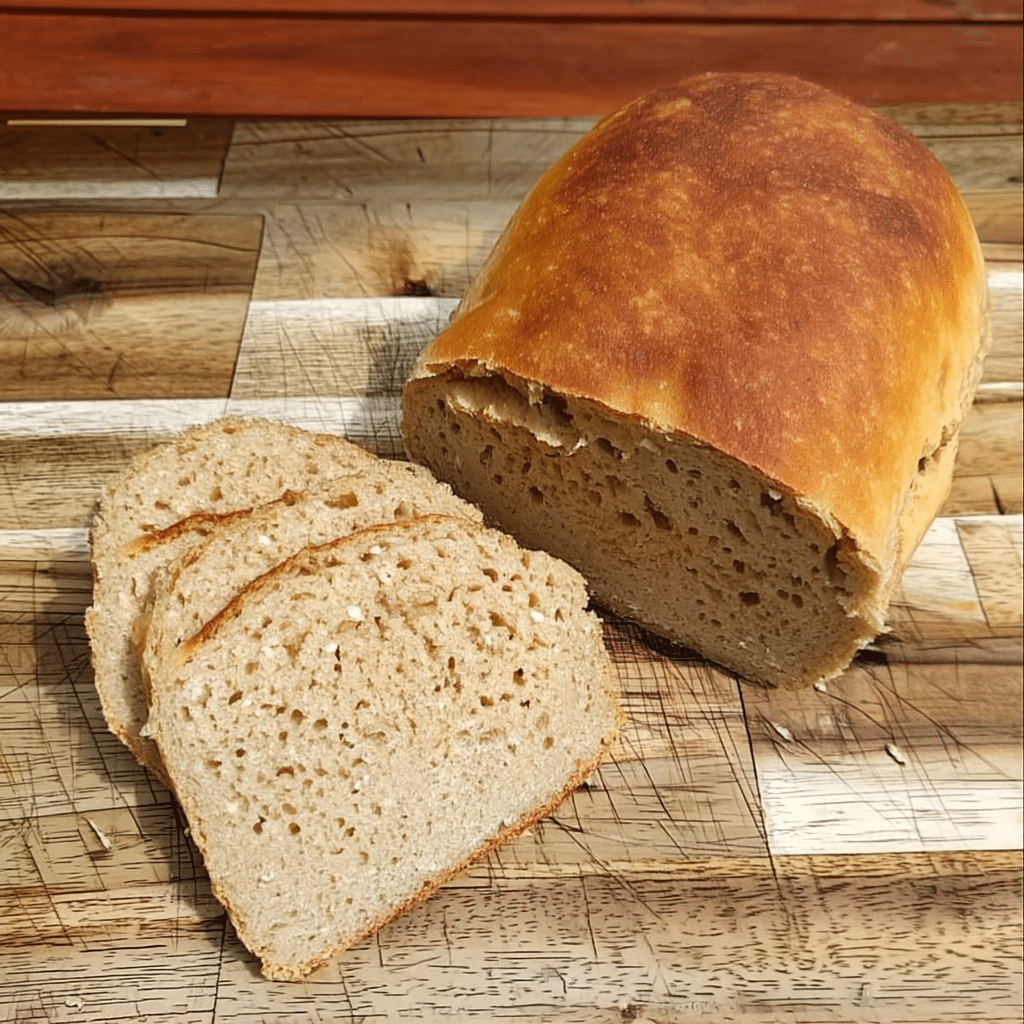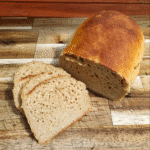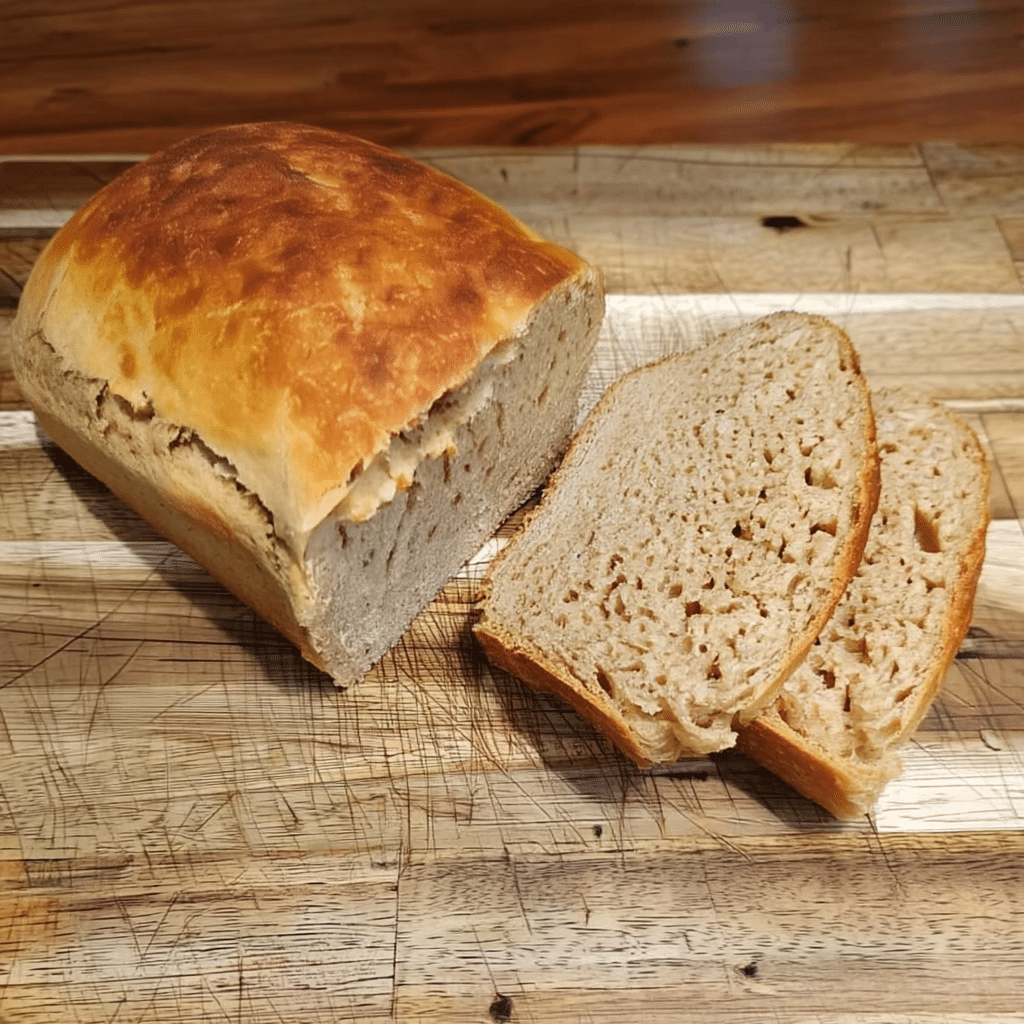Ever found yourself craving a slice of warm, wholesome bread—but without the post-carb crash or gut discomfort? I’ve been there too. As someone who loves rustic loaves but also lives by a clean, keto-ish lifestyle, I was thrilled when I stumbled upon kamut bread in a local Vermont co-op. It was rich, nutty, and surprisingly gentle on my digestion.
In this article, I’ll take you by the hand and walk you through everything I’ve learned—and loved—about this ancient grain superstar. From its origin story to how you can bake a loaf right in your kitchen, this is your cozy guide to kamut bread—the buttery, golden loaf that brings flavor and function together in the most nourishing way.

Table of Contents
Kamut Bread : The Ancient Loaf That’s Making a Comeback
Kamut Bread: Why This Ancient Grain Is Gaining Modern Fans
Have you ever wished bread could be both comforting and nourishing? That’s exactly how I felt the first time I tried kamut bread. It’s made from an ancient grain called khorasan wheat—famous for its buttery flavor and better digestibility than regular wheat.
Kamut’s roots go way back to ancient Egypt, but today, it’s winning hearts in modern kitchens—especially for folks who want high-protein bread that’s gentle on the gut. While it’s not totally gluten-free, many people with wheat sensitivity (like me!) find it easier to digest.
What I love most? The nutty taste, chewy texture, and how it keeps me energized without the usual carb crash. You can grab organic kamut flour online from places like Bob’s Red Mill or check your local natural food store.
So if you’re looking for a wholesome, low-gluten bread that actually satisfies, kamut bread might just become your new favorite.
Print
Kamut Bread: Health Benefits, Recipe, and Why It’s Worth Trying
- Total Time: 2 hours
- Yield: 1 loaf 1x
Description
A rustic, buttery kamut bread made with ancient grain flour, olive oil, and honey—perfect for clean, wholesome eating.
Ingredients
3 ½ cups kamut flour (preferably organic)
1 ¼ cups warm water
2 tablespoons olive oil
2 teaspoons instant yeast
1 tablespoon honey or monk fruit sweetener
1 teaspoon sea salt
Instructions
1. In a bowl, mix warm water, yeast, and sweetener. Let sit until bubbly (10 minutes).
2. In another bowl, combine kamut flour and sea salt.
3. Add the yeast mixture and olive oil to the dry ingredients and stir to form a rough dough.
4. Knead the dough for 8–10 minutes until smooth and elastic.
5. Place the dough in a lightly oiled bowl, cover, and let it rise for 1–2 hours until doubled.
6. Punch the dough down, shape it into a loaf, and let it rise again for 30–40 minutes.
7. Bake at 375°F (190°C) for 30–35 minutes or until golden and hollow when tapped.
Notes
For a gluten-reduced version, substitute part of the flour with almond flour.
To boost flavor, add rosemary, garlic, or sundried tomatoes to the dough.
Store wrapped at room temperature for 3 days or freeze for longer freshness.
- Prep Time: 20 minutes
- Cook Time: 35 minutes
- Category: Bread
- Method: Baking
- Cuisine: American
Nutrition
- Serving Size: 1 slice
- Calories: 140
- Sugar: 1g
- Sodium: 180mg
- Fat: 3.5g
- Saturated Fat: 0.5g
- Unsaturated Fat: 3g
- Trans Fat: 0g
- Carbohydrates: 25g
- Fiber: 3g
- Protein: 5g
- Cholesterol: 0mg
Keywords: kamut bread, ancient grain bread, healthy homemade bread
Understanding Kamut: The Golden Grain
What Is Kamut and Why It Deserves a Spot in Your Pantry
Ever stood in the grain aisle, overwhelmed by choices? I used to reach for the usual all-purpose flour—until I met kamut. It’s not just another buzzword. Kamut, officially known as khorasan wheat, is one of those ancient grains that quietly carries centuries of nutrition and flavor.
Origins and History of Kamut
Legend tells us it was first cultivated in ancient Egypt—some say it was even discovered in a pharaoh’s tomb. While that’s partly myth, what’s true is that this grain has roots that stretch back thousands of years.
Fast forward to the mid-20th century: kamut was reintroduced to North America by an American pilot who received a handful of the kernels from a friend. They were planted, tested, and eventually grew into what we now know as a hardy, flavorful, high-protein grain with global fans.
Nutritional Profile of Kamut
What makes kamut truly shine isn’t just its story—it’s what’s inside. Kamut naturally packs more protein, fiber, selenium, and magnesium than today’s common wheat varieties. That means more fuel for your body and longer-lasting energy, especially if you’re active like me and love trail days in Vermont.
Although it still contains gluten, kamut has a lower gluten content and a different structure that many people find easier on digestion. I’m not celiac, but I definitely notice less bloating and better focus after a kamut-based breakfast.
Plus, kamut is typically grown organically and non-GMO by default—so it aligns beautifully with the kind of clean eating we celebrate here on Fastryo.
With its buttery taste, nourishing profile, and heritage charm, kamut is more than a grain—it’s a return to eating simply and naturally.
Kamut Bread vs. Traditional Wheat Bread: What’s the Difference?
Kamut Bread vs. Traditional Wheat Bread: What’s the Difference?
When I first switched to kamut bread, I wasn’t expecting much—maybe just a slightly different taste. But after one bite, I could instantly tell: this wasn’t just another wheat loaf trying to be trendy. It was hearty, satisfying, and honestly, more comforting than anything I’d pulled off a shelf in years.
Texture, Flavor, and Nutrition
Let’s start with the obvious: texture and taste. Kamut bread offers a pleasant, slightly chewy texture that stands up perfectly when toasted. Its flavor carries rich, buttery, and nutty notes—something you won’t easily find in typical modern wheat. No need to smother it in toppings to enjoy it.
When it comes to nutrition, kamut sets itself apart. Unlike white or heavily processed wheat bread that’s often full of empty carbs, kamut bread is naturally rich in nutrients. It’s a protein-packed grain that delivers extra fiber, iron, magnesium, and a healthy dose of natural antioxidants. It doesn’t just fill you up—it fuels and nourishes your body.
Digestibility and Gluten Content
Now, if you’ve struggled with bread bloating or post-lunch fatigue, this might be the part that excites you most. Kamut contains less gluten than modern wheat and has a gentler protein structure. While it’s not gluten-free, many folks with mild wheat sensitivities find it far easier to digest. I know I do.
If you’re looking for a balanced bread that fuels your body without dragging it down, kamut bread could be your new pantry staple.
Why Kamut Bread Is a Smart Choice for Healthy Eating
The Health Benefits of Kamut Bread You’ll Feel in Every Bite
You know how some foods just feel good? That’s exactly how kamut bread lands on your plate. It’s not only tasty—it’s full of real nourishment that your body can actually use. Unlike ultra-processed white breads, kamut bread delivers benefits with every slice.
Packed with Protein and Antioxidants
First up, let’s talk about protein. Kamut flour naturally contains more of it than regular wheat, which makes it a better choice for those of us focused on healthy bread options that actually satisfy. That extra protein keeps cravings at bay and supports lean muscle.
But that’s not all. Kamut is also loaded with antioxidants like selenium—a trace mineral that helps reduce oxidative stress. Think of it as a small but mighty nutrient working behind the scenes to support your immune system and long-term health.
Heart-Friendly and Anti-Inflammatory
This ancient grain isn’t just packed with goodness—it’s also gentle on your body. Studies have shown that kamut may help lower bad cholesterol and support heart health, thanks to its anti-inflammatory grain properties. That means fewer blood sugar spikes, better digestion, and a happier gut.
If you’ve been dealing with post-meal fatigue or stubborn inflammation, adding a slice of kamut bread could be a small but meaningful shift in your routine.
Energy-Boosting Carbohydrates
Here’s something I love about kamut—it provides slow-digesting carbs that give you lasting energy without the crash. I often enjoy a slice of kamut toast with almond butter before heading out on a long morning hike. It fuels me, keeps me full, and tastes amazing too.
Homemade Kamut Bread Recipe: Rustic, Simple, Nourishing
How to Make Kamut Bread at Home the Easy Way
There’s something almost magical about baking bread from scratch—especially when it’s as wholesome and nourishing as kamut bread. I still remember the first time I tried baking with kamut flour. The dough felt silkier, the rise more fragrant, and the flavor? Buttery, earthy, and just plain beautiful. Let’s get into it.

Ingredients You’ll Need
This simple kamut bread uses clean, pantry-friendly ingredients. Here’s what you’ll need:
- 3 ½ cups kamut flour (organic if possible)
- 1 ¼ cups warm water
- 2 tablespoons olive oil
- 2 teaspoons instant yeast
- 1 tablespoon honey or a natural keto-friendly sweetener like monk fruit
- 1 teaspoon sea salt
Ryo’s tip: Try local stone-ground kamut flour for extra depth of flavor—it really shines.
Step-by-Step Directions
- Activate yeast: In a bowl, mix warm water, yeast, and honey. Let it bubble for 10 minutes.
- Combine dry ingredients: In a large mixing bowl, whisk together kamut flour and salt.
- Mix wet into dry: Add yeast mixture and olive oil into the flour. Stir until it forms a shaggy dough.
- Knead: Knead for 8–10 minutes until smooth and elastic.
- Let it rise: Place dough in a lightly oiled bowl, cover, and let rise for 1–2 hours until doubled.
- Shape and second rise: Punch down, shape into a loaf or round, and let it rise again for 30–40 minutes.
- Bake: Preheat oven to 375°F (190°C). Bake for 30–35 minutes until golden and hollow-sounding when tapped.
Substitutions & Storage Tips
- Gluten-free twist: Mix kamut with a gluten-free flour like almond flour (1:1) to lower gluten levels—though it won’t be celiac-safe.
- Add-ins: Chia seeds or flaxmeal for a keto-boosted loaf.
- Storage: Wrap tightly in beeswax wrap or store in a bread box for up to 3 days. For longer storage, slice and freeze.
Fun Variations and Delicious Ways to Serve Kamut Bread
Making Kamut Bread Your Own—Simple Variations and Cozy Pairings
Once you’ve got your basic kamut bread recipe down, the fun really begins. What I love most about baking is how easy it is to make every loaf feel personal. Kamut’s mild, buttery flavor pairs beautifully with both sweet and savory additions—so don’t be afraid to play around!
Savory Versions
If you’re anything like me, herbs are non-negotiable in the kitchen. One of my favorite versions is a rustic kamut loaf infused with fresh rosemary and minced garlic. It makes the whole house smell like a countryside bakery. You can also try chopped sundried tomatoes for a Mediterranean twist—it’s incredible with a bit of olive oil.
Sweet Touches
For a breakfast treat, mix in a touch of cinnamon and drizzle in honey or maple-flavored monk fruit syrup. The result is a cinnamon-honey kamut loaf that toasts like a dream. A slice with herbal tea? Heaven on a cold Vermont morning.
Best Pairings
When I’m in a rush, I toast a slice and top it with avocado and a pinch of sea salt. Other times, it’s almond butter or even cottage cheese with a sprinkle of cinnamon. Kamut bread’s sturdy texture makes it perfect for loading up with whatever your mood craves.
Where to Find Kamut Bread or Flour Near You
Where to Buy Kamut Bread or Flour Without the Guesswork
If you’re wondering where to buy kamut flour or freshly baked organic kamut bread near me, the good news is—it’s easier than ever. Whether you love the convenience of online shopping or prefer to browse your local market, there are plenty of options.
Online Stores
You can find trusted organic kamut products from big names like Amazon, Thrive Market, and Bob’s Red Mill. I personally love Bob’s for their commitment to clean milling practices—plus their flour bakes beautifully.
When shopping online, always check the label for “100% khorasan wheat” to make sure you’re getting the real deal—not a blend.
Local Health Stores
If you’re lucky enough to have a Whole Foods, Sprouts, or Natural Grocers nearby, pop in and check their bulk grain or specialty bread section. Ask the staff—many are happy to guide you to their ancient grain collection.
Kamut Bread and the Keto Lifestyle: Can They Coexist?
Is Kamut Bread Keto-Friendly or Low-Carb Enough?
If you’re following a strict keto diet, you might assume that kamut bread is off the table. And technically? You’d be right. Kamut is still a grain, which means it contains carbs. But that doesn’t mean it can’t work in a more flexible or clean keto lifestyle.
Kamut in a Modified Low-Carb or Clean Keto Diet
Kamut has slow-digesting carbs, which means it releases energy gradually—making it a better choice than refined bread if you’re cycling carbs or living active. I personally enjoy a small slice of kamut toast with almond butter before a morning hike. It keeps me fueled without the crash.
Ryo’s opinion: “I occasionally enjoy kamut toast on active days—it’s all about balance.”
So while it’s not ideal for strict keto, kamut bread can still be part of your routine—especially when quality, nourishment, and satisfaction matter more than counting every gram.
Ryo’s Closing Thoughts
If there’s one thing I’ve learned from baking my way through clean eating, it’s that real food always wins. Kamut bread isn’t just another wellness trend—it’s a nourishing, grounding staple that offers real flavor, rich nutrients, and a deep connection to ancient food wisdom.
Whether you’re looking for a better-for-you slice for toast, a high-protein bread option, or just want to try something new in your kitchen—kamut is worth it. It’s not about perfection. It’s about balance, intention, and what fuels you best.
So why not give homemade kamut bread a try? You’ve got the recipe, the tips, and now the inspiration. Bake a loaf, toast a slice, and enjoy the calm, cozy joy of knowing exactly what’s in your food.
With love from Ryo’s kitchen — follow Fastryo on Facebook and let me know what you think!
Kamut Bread FAQs
Is kamut bread gluten-free?
No—kamut bread is not gluten-free. Kamut is an ancient form of wheat, so it naturally contains gluten. However, it’s often described as a low-gluten grain because its protein structure is different from modern wheat. Many people with mild wheat sensitivity find it gentler, but it’s not suitable for those with celiac disease.
Does kamut bread help with digestion?
Yes, it can. Kamut bread is often praised for being easier on the digestive system. That’s thanks to its anti-inflammatory grain properties, natural fiber content, and lack of modern wheat processing. If you’ve felt bloated or heavy after eating conventional bread, kamut might be a better choice for your gut.
Can I eat kamut bread on a keto diet?
Technically, no—kamut bread doesn’t fit into a strict keto plan due to its carb content. But if you follow a flexible or keto-ish lifestyle, especially one focused on clean ingredients and slow-digesting carbs, a small serving of kamut bread can be a smart, satisfying choice.
What does kamut bread taste like?
Kamut bread has a rich, nutty, almost buttery flavor. It’s slightly sweet and has a hearty, chewy texture that makes it more filling and flavorful than standard wheat bread. It’s the kind of bread that stands on its own—even without toppings.
Is kamut bread better than sourdough?
That depends on what you’re looking for. Sourdough is fermented and often easier to digest, while kamut bread offers more protein, minerals, and a naturally sweet flavor. If you want a high-protein, ancient grain bread with a clean ingredient list, kamut is a winner.
